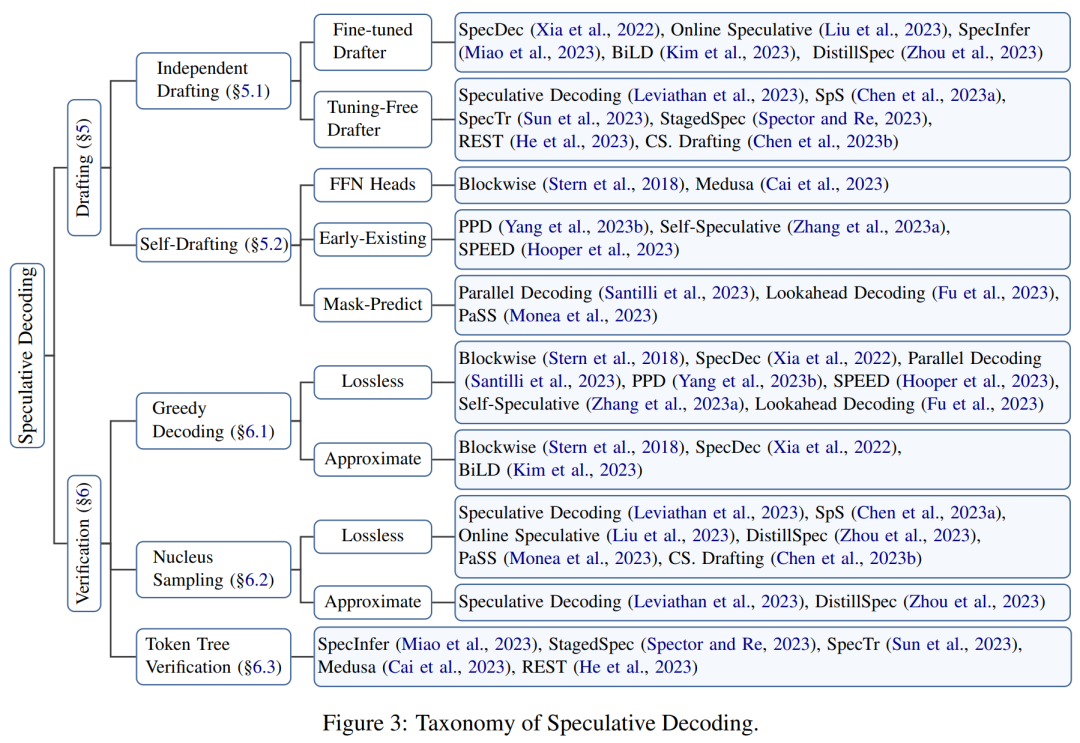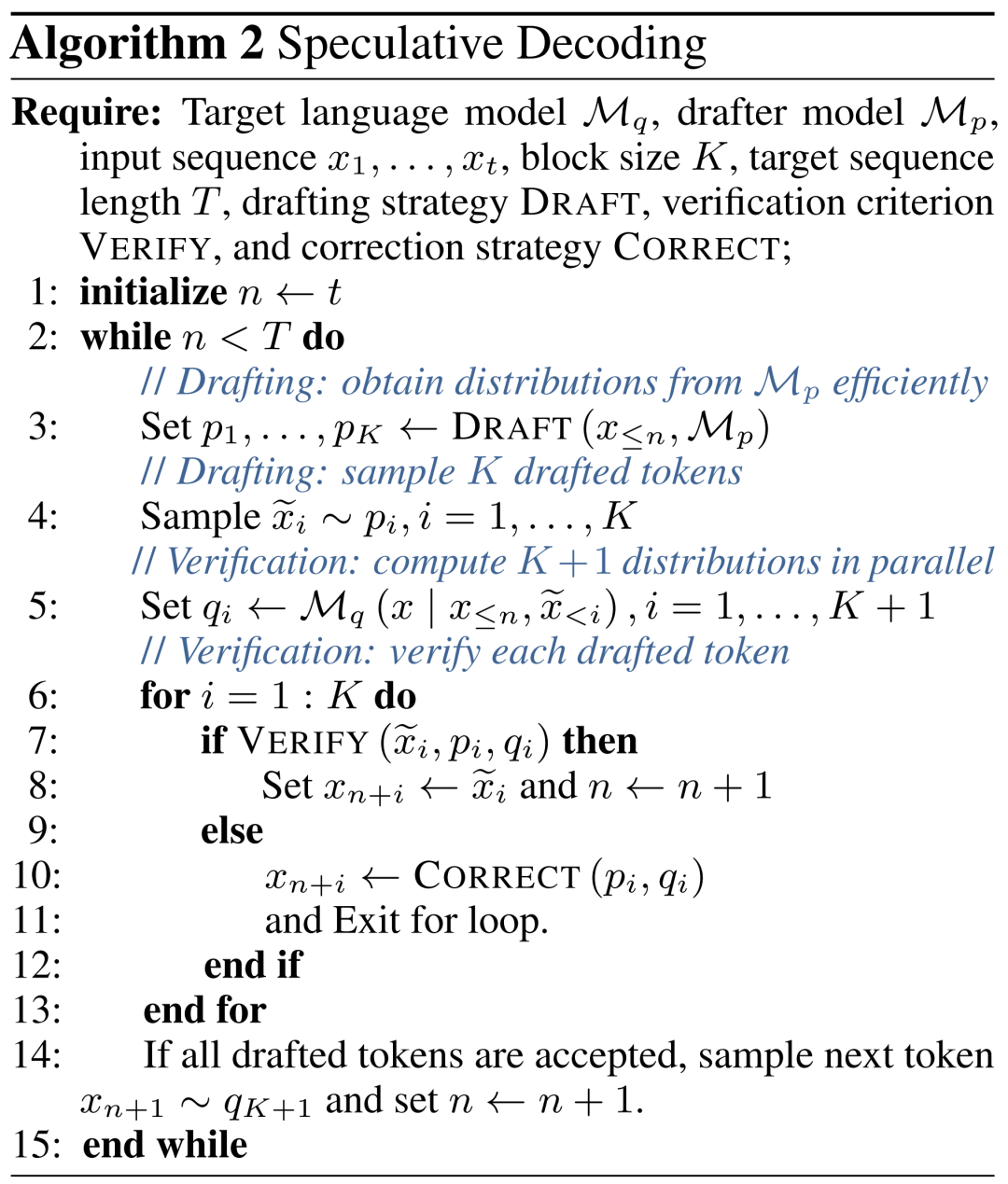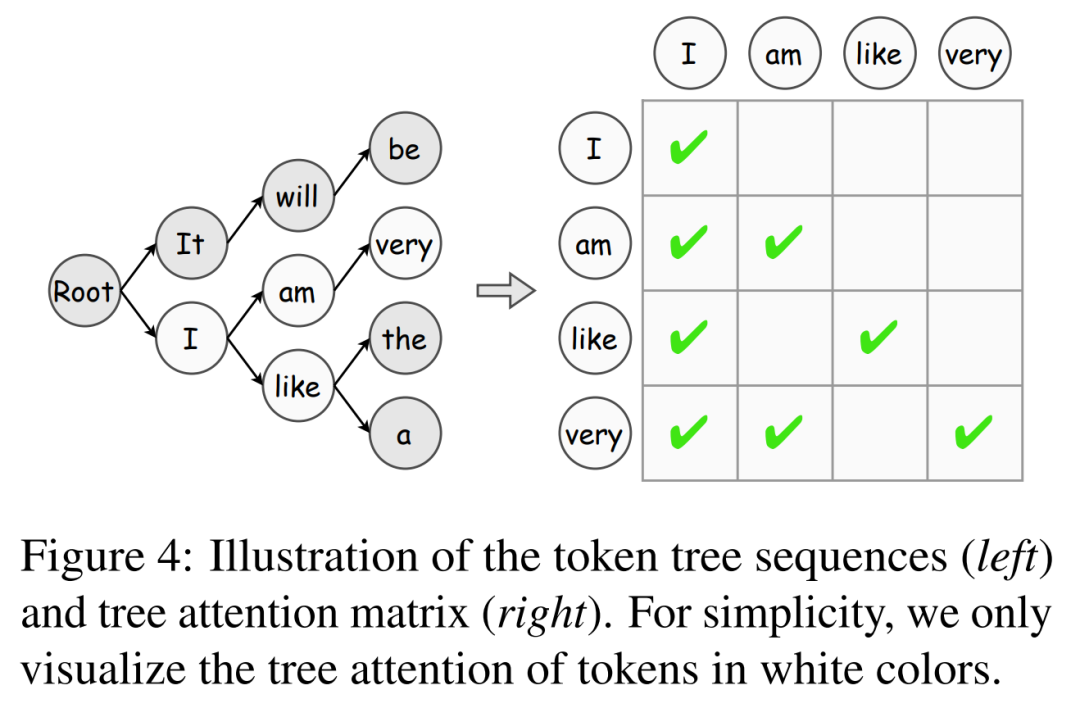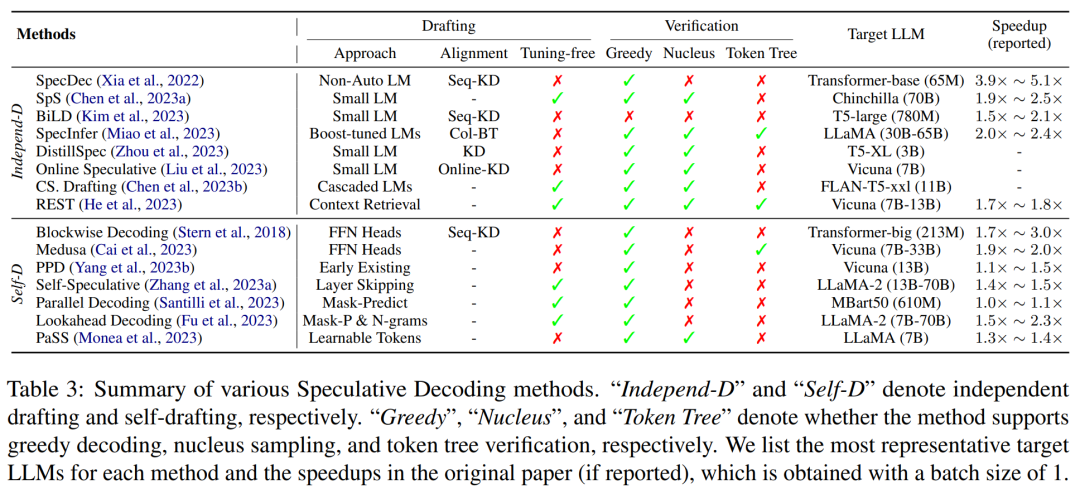 Technology peripherals
Technology peripherals
 AI
AI
 What is the speculative decoding that GPT-4 might also be using? An article summarizing the past, present and application situations
What is the speculative decoding that GPT-4 might also be using? An article summarizing the past, present and application situations
What is the speculative decoding that GPT-4 might also be using? An article summarizing the past, present and application situations
As we all know, the inference of large language models (LLM) usually requires the use of autoregressive sampling, and this inference process is quite slow. In order to solve this problem, speculative decoding has become a new sampling method for LLM inference. In each sampling step, this method will first predict several possible tokens and then verify whether they are accurate in parallel. Unlike autoregressive decoding, speculative decoding can decode multiple tokens in a single step, thus speeding up inference.
Although speculative decoding shows great potential in many aspects, it also raises some key issues that require in-depth research. First, we need to think about how to select or design an appropriate approximate model to strike a balance between the accuracy of conjecture and the efficiency of generation. Second, it is important to ensure that assessment criteria maintain both the diversity and quality of the results generated. Finally, the alignment of the inference process between the approximate model and the target large model must be carefully considered to improve the accuracy of the inference.
Researchers from Hong Kong Polytechnic University, Peking University, MSRA and Alibaba have conducted a comprehensive investigation on speculative decoding, and Machine Heart has made a comprehensive summary of this.

- ##Paper title: Unlocking Efficiency in Large Language Model Inference: A Comprehensive Survey of Speculative Decoding
- Paper address: https://arxiv.org/pdf/2401.07851.pdf
The evolution of speculative decoding
The article first introduces the early research status of speculative decoding technology in detail, and shows its development process through a timetable (see Figure 2) .
Blockwise Decoding is a method of integrating additional feedforward neural (FFN) heads on the Transformer decoder, which can generate multiple tokens in a single step.
In order to further fully exploit the potential of the block sampling algorithm, a speculative decoding solution is proposed. This algorithm covers an independent approximate model, usually using a specialized non-autoregressive Transformer, capable of performing generation tasks efficiently and accurately.
After the emergence of speculative decoding, some scholars then proposed the "Speculative Sampling Algorithm", which added lossless accelerated kernel sampling to speculative decoding.
Overall, these innovative attempts at speculative decoding have begun to strengthen the Draftthen-Verify paradigm and demonstrate great potential in LLM acceleration.

This section begins with a brief overview of the standard We return to the content of decoding, and then provide an in-depth explanation of speculative decoding algorithms, including a comprehensive description of the formal definition, methodology, and detailed elaboration of the algorithm.
This article proposes an organizational framework to classify related research, as shown in Figure 3 below.

The speculative decoding algorithm is a decoding mode that generates first and then verifies. At each decoding step, it first needs to be able to generate multiple possible tokens, and then use the target large language model to evaluate all these tokens in parallel to speed up Reasoning speed. Algorithm Table 2 is a detailed speculative decoding process.

Generate
At each decoding step, the speculative decoding algorithm first generates Multiple possible tokens serve as speculations on the output content of the target large language model.This article divides the generated content into two categories: independent drafting and self-drafting, and summarizes its formulas in Table 1 below. ##Verify on each decode In this step, the tokens generated by the approximate model are verified in parallel to ensure that the output quality is highly consistent with the target large language model. This process also determines the number of tokens allowed at each step, an important factor that can affect speedup. A summary of the various validation criteria is shown in Table 2 below, including those that support greedy decoding and kernel sampling in large language model inference. The sub-steps of generation and verification will continue to iterate until the termination condition is met, that is, the [EOS] token is decoded or the sentence reaches the maximum length. In addition, this article introduces the token tree verification algorithm, which is an effective strategy to gradually improve token acceptance. Improving guess accuracy is key to speeding up speculative decoding: predictions from approximate models The closer the behavior is to the target large language model, the higher the acceptance rate of its generated tokens. To this end, existing work explores various knowledge extraction (KD) strategies to align the output content of the approximate model with that of the target large language model. Blocked decoding first uses sequence-level knowledge extraction (Seq-KD) for model alignment, and uses sentences generated by the target large language model to train the approximate model. In addition, Seq-KD is also an effective strategy to improve the quality of parallel decoding generation, improving the generation performance of parallel decoding. The main characteristics of existing speculative decoding methods are summarized in Table 3 below, including the type of approximate model or generation strategy, model alignment method, supported evaluation strategy and degree of acceleration. In addition to being a general paradigm, recent The work also shows that some variants of speculative decoding exhibit extraordinary effectiveness in specific tasks. Additionally, other research has applied this paradigm to address latency issues unique to certain application scenarios, thereby achieving inference acceleration. For example, some scholars believe that speculative decoding is particularly suitable for tasks where the model input and output are highly similar, such as grammatical error correction and retrieval enhancement generation. In addition to these works, RaLMSpec (Zhang et al., 2023b) uses speculative decoding to accelerate retrieval augmented language models (RaLMs). Question 1: How to weigh the accuracy of predicted content and the efficiency of generating it? Although some progress has been made on this problem, there is still considerable room for improvement in aligning approximate models with what the target large language model generates. In addition to model alignment, other factors such as generation quality and determination of prediction length also affect the accuracy of predictions and deserve further exploration. Question 2: How to combine speculative decoding with other leading technologies? As a general decoding mode, speculative decoding has been combined with other advanced technologies to demonstrate its potential. In addition to accelerating large language models for plain text, the application of speculative decoding in multimodal reasoning, such as image synthesis, text-to-speech synthesis, and video generation, is also an interesting and valuable direction for future research. Please refer to the original paper for more details. 


Model Alignment

Application
Opportunities and Challenges
The above is the detailed content of What is the speculative decoding that GPT-4 might also be using? An article summarizing the past, present and application situations. For more information, please follow other related articles on the PHP Chinese website!

Hot AI Tools

Undresser.AI Undress
AI-powered app for creating realistic nude photos

AI Clothes Remover
Online AI tool for removing clothes from photos.

Undress AI Tool
Undress images for free

Clothoff.io
AI clothes remover

AI Hentai Generator
Generate AI Hentai for free.

Hot Article

Hot Tools

Notepad++7.3.1
Easy-to-use and free code editor

SublimeText3 Chinese version
Chinese version, very easy to use

Zend Studio 13.0.1
Powerful PHP integrated development environment

Dreamweaver CS6
Visual web development tools

SublimeText3 Mac version
God-level code editing software (SublimeText3)

Hot Topics
 1382
1382
 52
52
 Open source! Beyond ZoeDepth! DepthFM: Fast and accurate monocular depth estimation!
Apr 03, 2024 pm 12:04 PM
Open source! Beyond ZoeDepth! DepthFM: Fast and accurate monocular depth estimation!
Apr 03, 2024 pm 12:04 PM
0.What does this article do? We propose DepthFM: a versatile and fast state-of-the-art generative monocular depth estimation model. In addition to traditional depth estimation tasks, DepthFM also demonstrates state-of-the-art capabilities in downstream tasks such as depth inpainting. DepthFM is efficient and can synthesize depth maps within a few inference steps. Let’s read about this work together ~ 1. Paper information title: DepthFM: FastMonocularDepthEstimationwithFlowMatching Author: MingGui, JohannesS.Fischer, UlrichPrestel, PingchuanMa, Dmytr
 The world's most powerful open source MoE model is here, with Chinese capabilities comparable to GPT-4, and the price is only nearly one percent of GPT-4-Turbo
May 07, 2024 pm 04:13 PM
The world's most powerful open source MoE model is here, with Chinese capabilities comparable to GPT-4, and the price is only nearly one percent of GPT-4-Turbo
May 07, 2024 pm 04:13 PM
Imagine an artificial intelligence model that not only has the ability to surpass traditional computing, but also achieves more efficient performance at a lower cost. This is not science fiction, DeepSeek-V2[1], the world’s most powerful open source MoE model is here. DeepSeek-V2 is a powerful mixture of experts (MoE) language model with the characteristics of economical training and efficient inference. It consists of 236B parameters, 21B of which are used to activate each marker. Compared with DeepSeek67B, DeepSeek-V2 has stronger performance, while saving 42.5% of training costs, reducing KV cache by 93.3%, and increasing the maximum generation throughput to 5.76 times. DeepSeek is a company exploring general artificial intelligence
 AI subverts mathematical research! Fields Medal winner and Chinese-American mathematician led 11 top-ranked papers | Liked by Terence Tao
Apr 09, 2024 am 11:52 AM
AI subverts mathematical research! Fields Medal winner and Chinese-American mathematician led 11 top-ranked papers | Liked by Terence Tao
Apr 09, 2024 am 11:52 AM
AI is indeed changing mathematics. Recently, Tao Zhexuan, who has been paying close attention to this issue, forwarded the latest issue of "Bulletin of the American Mathematical Society" (Bulletin of the American Mathematical Society). Focusing on the topic "Will machines change mathematics?", many mathematicians expressed their opinions. The whole process was full of sparks, hardcore and exciting. The author has a strong lineup, including Fields Medal winner Akshay Venkatesh, Chinese mathematician Zheng Lejun, NYU computer scientist Ernest Davis and many other well-known scholars in the industry. The world of AI has changed dramatically. You know, many of these articles were submitted a year ago.
 Hello, electric Atlas! Boston Dynamics robot comes back to life, 180-degree weird moves scare Musk
Apr 18, 2024 pm 07:58 PM
Hello, electric Atlas! Boston Dynamics robot comes back to life, 180-degree weird moves scare Musk
Apr 18, 2024 pm 07:58 PM
Boston Dynamics Atlas officially enters the era of electric robots! Yesterday, the hydraulic Atlas just "tearfully" withdrew from the stage of history. Today, Boston Dynamics announced that the electric Atlas is on the job. It seems that in the field of commercial humanoid robots, Boston Dynamics is determined to compete with Tesla. After the new video was released, it had already been viewed by more than one million people in just ten hours. The old people leave and new roles appear. This is a historical necessity. There is no doubt that this year is the explosive year of humanoid robots. Netizens commented: The advancement of robots has made this year's opening ceremony look like a human, and the degree of freedom is far greater than that of humans. But is this really not a horror movie? At the beginning of the video, Atlas is lying calmly on the ground, seemingly on his back. What follows is jaw-dropping
 KAN, which replaces MLP, has been extended to convolution by open source projects
Jun 01, 2024 pm 10:03 PM
KAN, which replaces MLP, has been extended to convolution by open source projects
Jun 01, 2024 pm 10:03 PM
Earlier this month, researchers from MIT and other institutions proposed a very promising alternative to MLP - KAN. KAN outperforms MLP in terms of accuracy and interpretability. And it can outperform MLP running with a larger number of parameters with a very small number of parameters. For example, the authors stated that they used KAN to reproduce DeepMind's results with a smaller network and a higher degree of automation. Specifically, DeepMind's MLP has about 300,000 parameters, while KAN only has about 200 parameters. KAN has a strong mathematical foundation like MLP. MLP is based on the universal approximation theorem, while KAN is based on the Kolmogorov-Arnold representation theorem. As shown in the figure below, KAN has
 Kuaishou version of Sora 'Ke Ling' is open for testing: generates over 120s video, understands physics better, and can accurately model complex movements
Jun 11, 2024 am 09:51 AM
Kuaishou version of Sora 'Ke Ling' is open for testing: generates over 120s video, understands physics better, and can accurately model complex movements
Jun 11, 2024 am 09:51 AM
What? Is Zootopia brought into reality by domestic AI? Exposed together with the video is a new large-scale domestic video generation model called "Keling". Sora uses a similar technical route and combines a number of self-developed technological innovations to produce videos that not only have large and reasonable movements, but also simulate the characteristics of the physical world and have strong conceptual combination capabilities and imagination. According to the data, Keling supports the generation of ultra-long videos of up to 2 minutes at 30fps, with resolutions up to 1080p, and supports multiple aspect ratios. Another important point is that Keling is not a demo or video result demonstration released by the laboratory, but a product-level application launched by Kuaishou, a leading player in the short video field. Moreover, the main focus is to be pragmatic, not to write blank checks, and to go online as soon as it is released. The large model of Ke Ling is already available in Kuaiying.
 The vitality of super intelligence awakens! But with the arrival of self-updating AI, mothers no longer have to worry about data bottlenecks
Apr 29, 2024 pm 06:55 PM
The vitality of super intelligence awakens! But with the arrival of self-updating AI, mothers no longer have to worry about data bottlenecks
Apr 29, 2024 pm 06:55 PM
I cry to death. The world is madly building big models. The data on the Internet is not enough. It is not enough at all. The training model looks like "The Hunger Games", and AI researchers around the world are worrying about how to feed these data voracious eaters. This problem is particularly prominent in multi-modal tasks. At a time when nothing could be done, a start-up team from the Department of Renmin University of China used its own new model to become the first in China to make "model-generated data feed itself" a reality. Moreover, it is a two-pronged approach on the understanding side and the generation side. Both sides can generate high-quality, multi-modal new data and provide data feedback to the model itself. What is a model? Awaker 1.0, a large multi-modal model that just appeared on the Zhongguancun Forum. Who is the team? Sophon engine. Founded by Gao Yizhao, a doctoral student at Renmin University’s Hillhouse School of Artificial Intelligence.
 Tesla robots work in factories, Musk: The degree of freedom of hands will reach 22 this year!
May 06, 2024 pm 04:13 PM
Tesla robots work in factories, Musk: The degree of freedom of hands will reach 22 this year!
May 06, 2024 pm 04:13 PM
The latest video of Tesla's robot Optimus is released, and it can already work in the factory. At normal speed, it sorts batteries (Tesla's 4680 batteries) like this: The official also released what it looks like at 20x speed - on a small "workstation", picking and picking and picking: This time it is released One of the highlights of the video is that Optimus completes this work in the factory, completely autonomously, without human intervention throughout the process. And from the perspective of Optimus, it can also pick up and place the crooked battery, focusing on automatic error correction: Regarding Optimus's hand, NVIDIA scientist Jim Fan gave a high evaluation: Optimus's hand is the world's five-fingered robot. One of the most dexterous. Its hands are not only tactile



